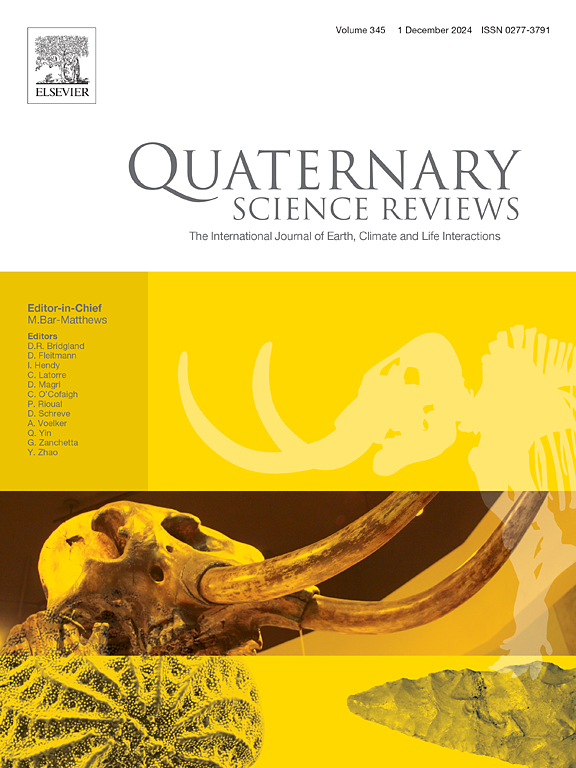Radiocarbon dating and isotopic paleoecology of Notiomastodon platensis (Mammalia: Proboscidea) from the late Pleistocene of Minas Gerais, Brazil
IF 3.2
1区 地球科学
Q1 GEOGRAPHY, PHYSICAL
引用次数: 0
Abstract
Proboscidea is a group of large mammals abundant in the fossil record and in Brazil it is represented by Notiomastodon platensis (Ameghino, 1888). To improve the understanding on its taxonomy, chronology, annual diet, and habitats paleoenvironmental aspects, we conducted a morphological description, absolute dating, and analysis of stable isotopes of carbon and oxygen (δ13C and δ18O) in Notiomastodon' remains from the northern (Norte de Minas) and western (Triângulo Mineiro) mesoregions of Minas Gerais State, Brazil. The material includes isolated teeth, mandibular portions, and postcranial bones at different levels of fragmentation, associated with at least eight adults and one juvenile. The only individual from Triângulo, found in Campina Verde municipality, was dated at 27,715–27,903 Cal yr BP. It presented a mixed diet based on C4 plants (piC4 = 90 %; δ13C = 0.5 ‰), which implies the occupation of an open environment, mostly pasture. The region was relatively humid (δ18O = 24.7 ‰), which is supported by the existence of humidity corridors in the Amazon region. A similar phytophysiognomy was inferred for the Norte de Minas region between at least 21,966–22,279 Cal yr BP and 18,944–19,157 Cal yr BP. However, one specimen showed a different δ13C value (piC3 = 0.87 %; δ13C = −10.2 ‰). This indicates it lived in a transitional environment between low-density forest and arboreal savannah. This likely occurred during a period that favored the expansion of trees and shrubs. The region underwent climate change, from relatively humid conditions (δ18O = 25.6 ± 0.2 ‰) to expressively dry (δ18O = 34.6 ‰) between the dated periods, a change corroborated by some palynological data. The multiannual paleoecological analysis, based on sequential sampling of three dentin layers of an incisor, indicated the relative stability of vegetation and climate despite fluctuations in hydrology. The perceived disassociation between vegetation dynamics and local hydrology corroborates the idea that factors other than precipitation may play a significant role in the environmental dynamics of the Cerrado biome.
巴西米纳斯吉拉斯晚更新世Notiomastodon platensis(哺乳纲:长鼻目)的放射性碳年代测定和同位素古生态学研究
长鼻目(Proboscidea)是化石记录中非常丰富的一类大型哺乳动物,巴西的代表动物是Notiomastodon platensis(Ameghino,1888年)。为了加深对其分类、年代学、年食性和栖息地古环境等方面的了解,我们对巴西米纳斯吉拉斯州北部(Norte de Minas)和西部(Triângulo Mineiro)中区的Notiomastodon遗骸进行了形态描述、绝对年代测定以及碳和氧稳定同位素(δ13C和δ18O)分析。这些材料包括孤立的牙齿、下颌骨部分和颅后骨骼,破碎程度不一,至少与八个成年个体和一个幼年个体有关。来自特里安古洛的唯一个体发现于坎皮纳韦尔德市,其年代为公元前 27,715-27,903 卡年。它的食物以 C4 植物为主(piC4 = 90 %;δ13C = 0.5 ‰),这意味着它生活在一个开阔的环境中,主要是牧场。该地区相对潮湿(δ18O = 24.7 ‰),亚马逊地区存在的湿度走廊也证明了这一点。至少在 21,966-22,279 Cal yr BP 和 18,944-19,157 Cal yr BP 之间,北米纳斯地区也有类似的植物生理学推断。然而,有一个标本显示了不同的δ13C 值(piC3 = 0.87 %;δ13C = -10.2‰)。这表明它生活在低密度森林和树栖稀树草原之间的过渡环境中。这很可能发生在有利于树木和灌木扩展的时期。在两个年代之间,该地区经历了从相对潮湿(δ18O = 25.6 ± 0.2 ‰)到明显干燥(δ18O = 34.6 ‰)的气候变化,一些古生物学数据也证实了这一变化。根据对一颗门牙的三个牙本质层的连续取样进行的多年度古生态分析表明,尽管水文存在波动,但植被和气候相对稳定。植被动态与当地水文之间的明显脱节证实了这样一种观点,即除降水外,其他因素也可能在塞拉多生物群落的环境动态中发挥重要作用。
本文章由计算机程序翻译,如有差异,请以英文原文为准。
求助全文
约1分钟内获得全文
求助全文
来源期刊

Quaternary Science Reviews
地学-地球科学综合
CiteScore
7.50
自引率
15.00%
发文量
388
审稿时长
3 months
期刊介绍:
Quaternary Science Reviews caters for all aspects of Quaternary science, and includes, for example, geology, geomorphology, geography, archaeology, soil science, palaeobotany, palaeontology, palaeoclimatology and the full range of applicable dating methods. The dividing line between what constitutes the review paper and one which contains new original data is not easy to establish, so QSR also publishes papers with new data especially if these perform a review function. All the Quaternary sciences are changing rapidly and subject to re-evaluation as the pace of discovery quickens; thus the diverse but comprehensive role of Quaternary Science Reviews keeps readers abreast of the wider issues relating to new developments in the field.
 求助内容:
求助内容: 应助结果提醒方式:
应助结果提醒方式:


